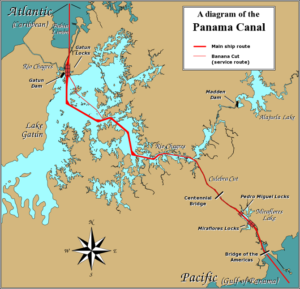The Panama Canal is 80 kilometers (50 miles) long and connects the Atlantic and Pacific oceans. This channel was cut through one of the narrowest point of the Isthmus that connects North and South America and has been named one of the seven wonders of the modern world by the American Society of Civil Engineers. The Canal uses a system of locks – compartments with entrance and exit – which function as water lifts that raise ships from sea level (the Pacific or Atlantic) to the level of Gatun Lake (26 meters above sea level them). The boats sail the channel through the Continental Divide to reach the opposite shore. Each set of locks bears the name of the site of the original city where it was built: Gatun  on the Atlantic side and Pedro Miguel and Miraflores on the Pacific side. The water used to raise and lower vessels in each set of locks comes from Gatun Lake by gravity and flows into the locks through a system of culverts that extend under the lock chambers of the side walls and central wall. The narrowest part of the Canal is Gaillard Cut, which extends from the north end of Pedro Miguel Locks to the southern tip of Lake
on the Atlantic side and Pedro Miguel and Miraflores on the Pacific side. The water used to raise and lower vessels in each set of locks comes from Gatun Lake by gravity and flows into the locks through a system of culverts that extend under the lock chambers of the side walls and central wall. The narrowest part of the Canal is Gaillard Cut, which extends from the north end of Pedro Miguel Locks to the southern tip of Lake  Gatun in Gamboa. This segment, approximately 13.7 kilometers long, is carved into the rock and limestone of the Continental Divide. Ships worldwide transit daily through the Panama Canal – about 13,000 to 14.000 vessels use the Canal every year and commercial transportation activities through the Canal represent approximately 5% of world trade. The channel has a staff of about nine thousand five hundred (9500) employees and operates 24 hours a day, 365 days a year, providing transit service to ships of all nations without discrimination.
Gatun in Gamboa. This segment, approximately 13.7 kilometers long, is carved into the rock and limestone of the Continental Divide. Ships worldwide transit daily through the Panama Canal – about 13,000 to 14.000 vessels use the Canal every year and commercial transportation activities through the Canal represent approximately 5% of world trade. The channel has a staff of about nine thousand five hundred (9500) employees and operates 24 hours a day, 365 days a year, providing transit service to ships of all nations without discrimination.
Our related Daytours:
Panama canal transit aboard a sailboat
